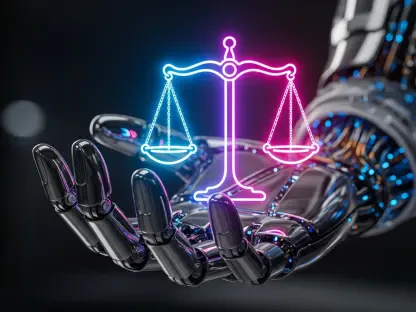Imagine a world where artificial intelligence systems, integral to everything from healthcare diagnostics to social media algorithms, operate without clear rules, potentially risking privacy, safety, and fairness on a massive scale. This scenario is becoming less likely in Europe, where a pioneering framework has emerged to address these concerns head-on. The European Union’s General Purpose AI Code of Practice, a voluntary precursor to mandatory regulations, stands as a bold attempt to govern AI development with an emphasis on transparency and accountability. Unveiled as a stepping stone toward stricter laws, this code is already influencing tech giants across the Atlantic, raising questions about its impact on innovation and global standards.
Core Features of the Framework
Transparency and Accountability Mechanisms
At the heart of this EU initiative lies a strong push for transparency in AI development. Companies are encouraged to disclose detailed information about data sourcing and training materials used in their models. This focus aims to demystify the often opaque processes behind AI systems, ensuring users understand how decisions are made, especially in high-risk applications like employment screening or medical analysis.
Beyond disclosure, accountability is a cornerstone of the framework. It seeks to protect user rights by mandating clear documentation and oversight, particularly for systems that could impact fundamental freedoms or safety. This approach is designed to build trust, ensuring that developers are answerable for the societal effects of their technologies.
Copyright Compliance Standards
Another critical feature is the stringent stance on copyright adherence. The code explicitly bans the use of pirated content for training AI models and requires companies to honor content owners’ opt-out requests. This rule challenges existing practices, particularly among firms that have relied on broad datasets without explicit permission.
This emphasis on intellectual property protection contrasts sharply with more lenient interpretations in other regions, such as the reliance on fair use doctrines in the United States. For developers, this means rethinking data acquisition strategies to align with a more restrictive legal environment, potentially reshaping how AI models are built from the ground up.
Safety and Security Protocols
Safety and security form a vital pillar of the EU’s framework, with specific obligations aimed at mitigating risks posed by AI technologies. High-risk systems, defined as those affecting public health or fundamental rights, must undergo rigorous assessments to identify and address potential harms before deployment.
These protocols prioritize structured risk management, requiring developers to implement safeguards against misuse or unintended consequences. By embedding such measures, the code aims to prevent scenarios where AI systems could exacerbate biases or endanger public welfare, setting a precedent for responsible innovation.
Performance and Industry Reception
Adoption and Resistance Among Tech Giants
Since its rollout, the code has seen significant uptake among major American technology companies, including Amazon, Google, and Microsoft, signaling a pragmatic acceptance of looming regulatory expectations. Their participation reflects a strategic move to prepare for mandatory compliance by 2027, potentially easing future administrative burdens.
However, not all responses have been positive. Meta, for instance, has declined to adopt the framework, citing legal ambiguities and concerns over scope exceeding forthcoming laws. This resistance underscores a broader tension within the industry, where some fear that early alignment might compromise competitive edges or expose proprietary information.
Competitive Implications and Challenges
The framework’s rigorous demands, especially around copyright and transparency, pose notable challenges for American firms accustomed to less restrictive environments. Critics, including industry leaders like Google’s Kent Walker, argue that such rules could stifle innovation by slowing development cycles and risking trade secret leaks.
Moreover, there’s a perceived disparity in impact, with established tech giants better equipped to absorb compliance costs compared to smaller startups. This dynamic raises questions about whether the code might inadvertently widen the gap between industry leaders and emerging players, potentially hindering diversity in AI advancement.
Global Influence and Regulatory Trends
Comparison with U.S. Approaches
A striking contrast exists between the EU’s risk-averse, structured governance and the more fragmented, innovation-driven landscape in the United States. While the EU categorizes AI by risk levels and imposes strict obligations, American regulation remains a patchwork of state laws and limited federal oversight, often prioritizing rapid growth over comprehensive control.
This divergence creates a complex environment for multinational companies, which must navigate differing expectations across markets. The EU’s proactive stance, with its voluntary code as a testing ground, could pressure other regions to adopt similar measures, especially as public demand for privacy and safety grows globally.
Potential as a Global Standard
Looking ahead, the framework holds potential to become a de facto benchmark for AI governance worldwide. Its widespread adoption by leading firms, coupled with the EU’s significant market influence, suggests that even non-European companies may align with these standards to maintain access and credibility.
Expert opinions reinforce this possibility, highlighting how consumer expectations for data protection could drive regulatory convergence. If this trend continues, the code might bridge gaps in less regulated markets, shaping a unified approach to AI ethics and accountability over the coming years, particularly by the mandatory enforcement deadline in 2027.
Final Thoughts and Path Forward
Reflecting on the journey so far, the EU’s General Purpose AI Code of Practice has emerged as a pivotal tool in navigating the uncharted waters of AI governance. It challenges industry norms with its focus on transparency, safety, and copyright, prompting both collaboration and contention among global tech leaders. Its influence stretches beyond European borders, compelling American firms to reassess strategies in light of forthcoming mandates.
Moving forward, stakeholders must prioritize dialogue to address competitive concerns and legal uncertainties that hinder full adoption. Collaborative platforms involving regulators, companies, and innovators could refine the framework, balancing protection with progress. Additionally, investing in tools and training to support smaller firms in meeting compliance demands would ensure a more equitable impact. As the deadline of 2027 approaches, these steps become essential to harmonize global practices, turning initial resistance into a foundation for sustainable AI development.









